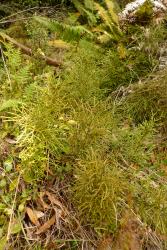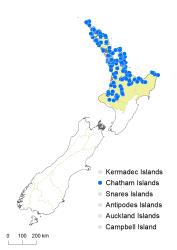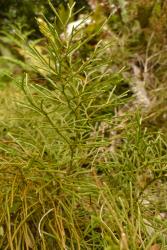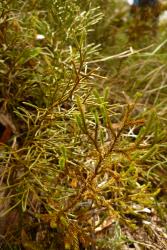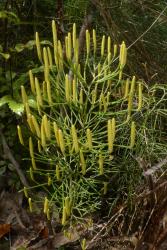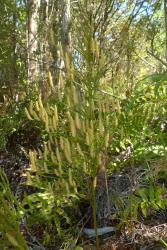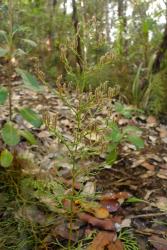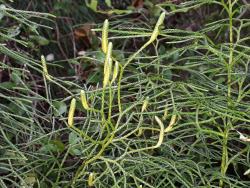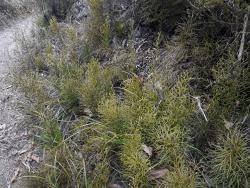- Taxon
- Gallery
- ≡ Lycopodium densum Labill., Nov. Holl. Pl. 2, 104, t. 251, f.1 (1807) nom. illeg., non Lycopodium densum Lam. 1778
- ≡ Lepidotis densa Rothm., Feddes Repert. Spec. Nov. Regni Veg. 54: 67 (1944) nom. nov. pro Lycopodium densum Labill. 1807
- ≡ Pseudolycopodium densum (Rothm.) Holub, Folia Geobot. Phytotax. 18: 442 (1983)
Horizontal stems dichotomously branching, subterranean, 1–4 mm diameter, bearing roots at intervals; leaves colourless, imbricate, appressed, narrowly ovate, adnate. Aerial stems, erect, branching monopodial, glabrous; longest fertile stems 150–1900 mm tall, 40–280 mm wide; unbranched portion of stem 25–750 mm long, branched portion 110–1650 mm long. Branches either horizontal, curling upwards or erect. Sterile leaves monomorphic, spirally arranged, dull green or orange-brown, often black-tipped especially on unbranched portions of stems; leaves on unbranched portion of aerial stems appressed, narrowly ovate to ovate, apices long acuminate, margins ciliate and membranous, bases adnate, 3–6 mm long, 0.8–1.3 mm wide; leaves on fertile aerial branches appressed, narrowly ovate, apices acuminate, margins entire or minutely ciliate, bases adnate, 1.7–3.0 mm long, 0.4–0.6 mm wide; leaves on juvenile aerial branches often spreading and larger than on mature branches. Sporophylls appressed when young, spreading at maturity, ovate to broadly ovate, apices acute or acuminate, margins ciliate and membranous, bases adnate to subpeltate, 2–3 mm long, 1–2 mm wide, aggregated into strobili. Strobili solitary or occasionally paired, terminal on branches, erect or ascending, sessile, yellow to yellow-brown, 3–40 mm long, 2.5–7 mm wide.
Lycopodium deuterodensum is recognised by its dendroid aerial stems, which arise from subterranean horizontal stems; its ultimate branches, which are either erect or curl upwards; and its strobili, which are erect or ascending. On mature stems the sterile leaves are appressed, but juvenile stems sometimes have spreading leaves.
North Island: Northland, Auckland, Volcanic Plateau, Gisborne, Taranaki.
Chatham Islands.
Altitudinal range: 0–1050 m.
Lycopodium deuterodensum occurs in coastal and lowland sites from Te Paki to East Cape and inland Taranaki, extending locally into montane areas. It grows from near sea-level up to about 1050 m on Mt Tihia and Mt Pihanga, south of Lake Taupō. It has been collected on the Chatham Islands (WELT P003684, P004311; not recorded by de Lange et al. 2011), and may now be extinct there.
Also Australia (South Australia, Queensland, New South Wales, Victoria, Tasmania) and New Caledonia.
Lycopodium deuterodensum grows most commonly as a terrestrial species in mānuka and kānuka scrub, but also occurs under kauri and broadleaved forest, and on gumland, stabilised dunes, podsols or clay soils. It often grows in extensive colonies, either on swampy ground or under dry scrub. It is occasionally found in Eucalyptus plantations.
2n = 68 (Murray & de Lange 2013).



